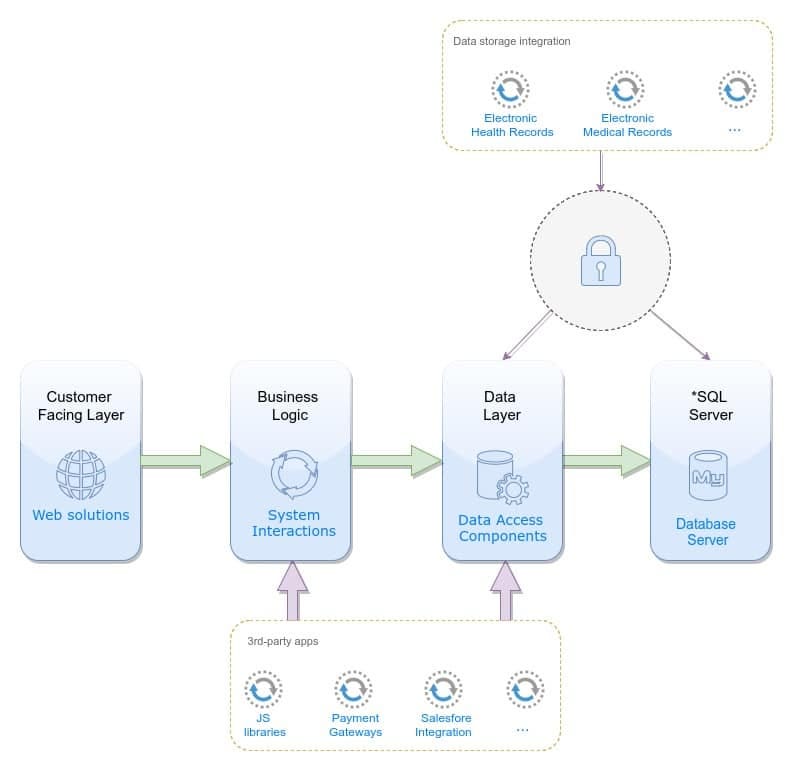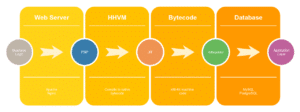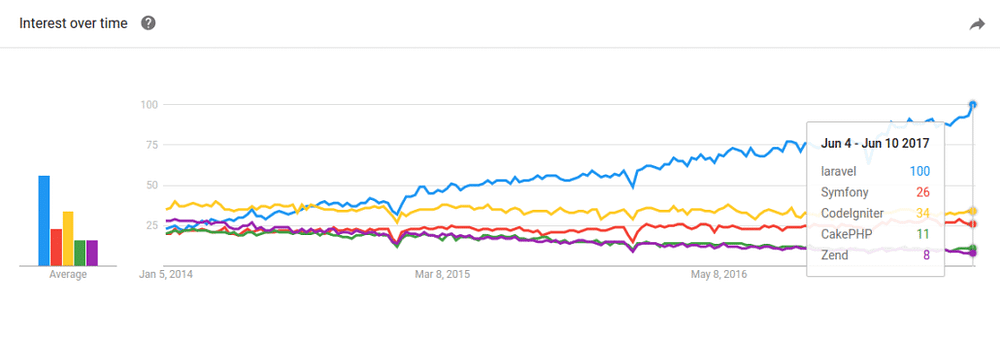The real challenge for all businesses is to achieve more with less, faster. Numbers mean everything, and fast results rule. In their search for a quick turnaround, large businesses tend to seek a reliable software solution with a proven history of successful integration. But these “time-tested” solutions can be more clunky than innovative.
In this way, businesses often play it safe. The last thing a business leader needs is uncertainty or a rush to the start of development.But what is much worse is to miss an opportunity to find a better solution. Exploring other options on the table is the first step towards a more elegant solution and a more competitive business model.
What is Enterprise Software?
Enterprise software is typically a business management tool built for an organization’s specific needs. Unlike client-facing software, which is built around a marketing concept, enterprise software often refers to internal solutions that align with a particular corporation’s activities. An enterprise solution could be a content management system (CMS), a customer relationship management tool (CRM), an enterprise resources planning system (ERP), or any other tool that manages the organization’s assets.
Enterprise software needs to be:
- Reliable
- Secure
- Scalable
- Powerful
- Independent
A typical enterprise solution — let’s say for a healthcare organization — would need to have high availability, a plan for disaster recovery, and be able to guarantee the privacy of its customers. It must comply with the regulations and laws of each country in which it is intended to operate. The solution should also include features like a real time reporting feature and an extended monitoring tool.
It would most certainly need encryption over the data access layer and protection of the hosting solution, like an SSL certificate, IP restrictions or blacklists, automatic database backups. It may require complex business logic with a variety of third-party software integrations, such as a realtime messaging system, PDF reporting, diagnostic tools, data imports and exports, LDAP, or another directory access service. Additional layers may need to be implemented over the data access in order to guarantee redundancy and continuous data flow.
Why PHP Application Development Works for the Enterprise
It is easy to mistake PHP for a simple, functional language, suitable only for small businesses and low user loads. But this couldn’t be further from the truth. In fact, developing PHP for use in the enterprise is on the rise.
A programming language is just a tool that helps to develop the software, but it doesn’t build the solution. Teams must start with the system architecture.
Ever since PHP 5.0 came out in 2004 (but especially after PHP 5.6 was released in 2014), enterprises began to leverage PHP application development began to power huge platforms like Facebook, Vimeo and WordPress. Why is this? It responds to the following business needs as it provides the architecture that supports robust solutions:
- Development speed
- Scalability
- Support
- Reasonable cost
Community, Diversity, and Speed
PHP application development is based on an open source and cross-platform language, and so it has one of the largest support communities. Its numbers make PHP developers easier to locate and hire, and the majority of them have a broad knowledge of other common web technologies. The typical PHP team is likely to be cross-functional and knowledgable of CSS3, HTML5, MySQL, MongoDB, Vanilla JavaScript, or JS frameworks — well enough to the point where they can provide all necessary expertise.
Additionally, with the rise of full stack web developers, the same engineer who builds backend and frontend architectures may as well set up the production environment and handle server configurations on AWS or other hosting providers. This level of flexibility generally means faster development and shorter time to go live, especially when working on tight deadlines.
According to StackOverflow’s annual survey, full-stack developers use between 4 and 5 major programming languages, the three most common being SQL, JavaScript, and PHP.
Teams that are familiar with more technologies can be flexible throughout development cycles and are better equipped to handle changes made to their composition. This also encourages a more nuanced approach to different elements of a project, such as proposed libraries or extensions across the front-end, back-end, database, and server side.
Scalability and Performance in PHP Application Development
The biggest myth around PHP application development is that, unlike Java and .NET, PHP doesn’t scale, making PHP application development unsuitable for use by the enterprise.
But this is false. The major overhead in web applications comes from either network traffic or the database connection. Higher performance means load faster or load less.
- Faster loading in web can be handled perfectly well either on the client side or via a caching technique on the server. PHP already comes with support for tools such as APC, Redis, and Memcached right out of the box. They cache parts of the code or the database objects and store them directly in the server’s’ memory. From there they are instantly loaded on the next call with practically zero latency.
- Less load is simple — limit the number of all connections and requests to the database and performance will rise through the roof. If this isn’t possible, then distribute the workload across more servers via load balancing and get the same effect.
Most hosting providers, such as Amazon AWS or Rackspace, offer load balancing with little to no PHP backend configuration. It doesn’t even matter if resources are server dependent. In a worst case scenario, it is required that they are shared across all servers. The clustering mechanisms in PHP guarantee fault tolerance. This means failure in one of the nodes does not affect the rest in the chain, and the application is left up and running.
Additionally, ever since Facebook introduced HHVM, the infrastructure started to change, and so did the understanding of what is now achievable when developing PHP apps.
HHVM (HipHop Virtual Machine) boosts performance and lowers the load to its minimum. It transforms PHP (and Hack) code to bytecode via the JIT compiler, performs additional optimizations, and translates everything to machine code. This lowers the latency and speeds up code execution on the server.
But even without HHVM, the new PHP 7 comes with a range of performance improvements, such as faster execution engine, native local thread storage, multithreading, and reduced memory usage. One could argue that PHP 7 is the fastest server side language, and while this may be subjective and based on personal preferences, it is true that the language is now more powerful than ever and scalability is not the real issue at all. Instead, the issue is designing the proper architecture that is best suited to support a complex enterprise systems.
PHP 5.6 (even more so than PHP 7) offers the right tools to achieve great scalability, performance, and reliability with less effort in configurations and server maintenance.
Development and Support for PHP Application Development
PHP powers the top three CMS engines: WordPress, Joomla, and Drupal. It’s unlikely that this lineup will change anytime soon. According to wordpress.com, the system powers 27% of the internet and counting. That shouldn’t come as a big surprise. Taking advantage of ready-to-use platforms that provide all the necessary tools to represent a business’s brand, marketing strategy, or ecommerce tool is cheap, fast, and it promises long term support. Additionally, anything that isn’t part of the platform’s core functionality is almost guaranteed to be found as a plugin or an extension.
Of course, WordPress and its competitors’ platforms are not suited for every business. Often there is a need for a much bigger architecture that combines a variety of internal and external tools. From payment integration to tools for linking with EHR or a similar electronic records system, real-time messaging, complex reporting, resource monitoring, and many more. Still, using existing frameworks eliminates the resources required when building from scratch, and they can provide a skeleton for a well organized architecture to which to start building robust enterprise software.
PHP application development can be supported with several prominent and mature frameworks that incorporate great architectural concepts like dependency injection (DI), aspect oriented programming (AOP), caching, inversion of control (IoC), transaction management, SOLID, and others. Among the most popular PHP are Symphony2+, Laravel 5+, Zend, Yii2+, Phalcon, and CakePHP, with Laravel gaining the most interest since 2016.
Not only can those frameworks speed up development and offer long-term support, but they actually lower the effort required because they provide many bundled components like authorization, authentication, roles and access management, and more, out of the box. This allows for a modular approach, separating the business logic from all common features, so the development team can focus entirely on the specifics of the application.
Frameworks basically abstract the business rules from all low-level details. They add a well-defined structure to the code and automate common processes like defining database entities, creating annotations and repositories, securing all database connections and requests, and speeding up unit testing. It’s fair to say that PHP application development frameworks force developers to write good, maintainable code, and to follow best coding standards. This, and the large base of the PHP application development communities — especially with Laravel — guarantee continuous support and a possible solution to any complex logical problem.
If you want to build enterprise software, chances are you want a long-term solution with access to technical support. Anyone with the proper skillset, and not just the original development team, should be able to enhance their capabilities for developing PHP apps and more. The diversity of PHP developers brings exactly that — engineers who code with multiple web languages, but also people who are very familiar with the variety of frameworks and can jump into development projects right away.
Ask the Right Questions at Development Kickoff
Asking the right questions to gain as much intelligence on the business as possible will help teams to build the right solution and the architecture that will support it best, regardless of development language.
Reduce Total Cost by Developing PHP Apps
The following aspects of PHP app development result in a faster development speed and a lower cost for the whole project:
- a large community of PHP engineers, the vast majority of which are familiar with many additional web technologies that might be required for a complete build;
- the enormous pool of pre-built modules for direct integration
- the processing workflow (unlike Java, PHP doesn’t need to compile and gives instant output)
So, can developing PHP apps save money, time, and effort? The answer is yes. As long as the proper architecture, designed in its foundations, and a powerful framework (like Laravel) back it up, PHP application development — whether for the enterprise or startup — can be successful.
How Sustainable is Support for PHP Application Development?
When it comes to maintenance, PHP is really serious about its long term support. The previous LTS version — 5.6, released mid 2014, will receive support through 2018. If a development team chooses PHP 7 now, it can anticipate at least five years of official PHP support for that version of the language. By the time support for the current version expires, an upgraded version of PHP will already be available on the market with a similar support lifecycle.
LTS is a warranty where, should any vulnerabilities or bugs be found, they will be patched quickly by PHP engineers. Since there is such a huge community of PHP developers, there’s practically zero chance for a security bug to go unnoticed for even a couple of hours.
LTS is a warranty where, should any vulnerabilities or bugs be found, they will be patched quickly by PHP engineers. Since there is such a huge community of PHP developers, there’s practically zero chance for a security bug to go unnoticed for even a couple of hours.
Additionally, thanks to PHP’s outstanding dependency manager, Composer, any ready-to-use component, such as an authorization bundle or a user management tool, is automatically taken care of when updating to a newer version of the bundle. Managing the external package dependencies is no longer a burden for the development team. This is a great time-saver that brings stability and security to the solution in the long run.
How Developing PHP Apps Helps Teams Build New Skills
The development team’s collective skill level in the chosen framework will determine the outcome of a project (keeping, of course, any external or unaccounted for circumstances, out).
PHP application development and its frameworks have large support communities and extensive training materials. The ease of access allows PHP developers to grow their skills quickly and at little-to-no cost for training courses or certificates. Additionally, the language specifics make for a perfect Agile process, in which the development team produces increments in iterative steps and the time to market is effectively decreased. The ability to prioritize incoming work allows for smoother progress and more mindful planning of future releases.
Why Teams Should Be Pro-Solution and Language Agnostic
The language chosen in a development project is simply a computing tool meant to solve a specific business need. The choice of what platform to use for a specific case should evolve around its purpose, target, budget, and available support. The right solution should be based on the most acceptable combination of those elements.
.NET and Java are two great platforms for enterprise software. A big part of their popularity is due to their stability and scalability, but also to the popularity of Microsoft and Oracle. But teams developing PHP apps can create software that is just as stable and scalable, and is even backed by powerful frameworks like Symfony and Laravel.
While enterprises should investigate how they can benefit from PHP application development, the final choice of architecture and technology should serve the business need, not vice versa.








No comments:
Post a Comment